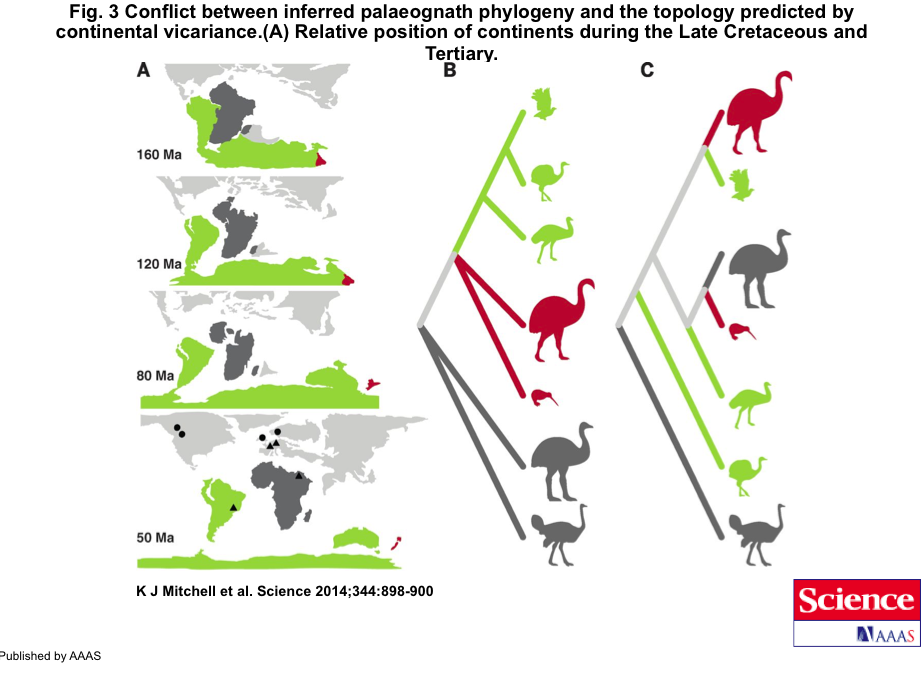
It has been discovered that largosity and flightlessness, which perhaps fortunately tend to go together in birds, evolved more than once.
The original story is that emus and ostriches and moas and such evolved as a separate group of birds from all the other birds, from the basal birdish thing that gave rise to all the living birds, and became a large land bird. This was on Gondwana. Later the continents broke up into smaller regions such as South America, Africa, Asia and such, an a few smaller pieces like Madagascar and New Zealand as well. These all had their own sub population of one or more species of large land bird, and these populations, in turn, give us the large lane birds we have today, except on Madagascar where the Elephant Bird went extinct (recently).
So, to summarize, the ancestors of the African Ostrich, Madagascar Elephant Bird, the New Zealand Moa and Kiwi, for example, would all have been together on one big continent and as that continent broke up these different populations, separately, evolved independantly into different birds, a process called “vicariance” (evolution by geographic separation).
It turns out this is partly wrong. Yes, the Ratites, as they are known, broke off from the other bird lineage as a separate monophyletic thing, separate from all the other birds today. Yes, they were large flightless birds, eventually. But two things are different. It seems that they could fly, quite possibly all of them, and it seems that some of them flew between the afore mentioned land masses, colonizing them, well after the Gondwana breakup. Then they settled down and evolved, or re-evolved, into mostly largish but variously sized land birds. Like nothing had happened. Hoping to not be noticed. To be more specific, the Kiwi descends from a bird that FLEW there from Africa or Madagascar and then became the kiwi.
It is notable that the basal Ratite, the South American Tinamous, flies. This suggests that Ratites flew, and the story was nice and clean. A flying but biggish (as in chicken-turkey-size) bird gave rise to a basal non-flying bird that broke up through vicariance into the diversity we see today. But instead, it seems that the evolution of flightlessness happened more than once, at least in the Kiwi. This leaves open the possibility of much greater complexity in the history of Ratite evolution. Or maybe it was just the Kiwi that did this thing.
This was figured out actually a couple of years ago with the study of some ancient DNA from Elephant Birds in Madagascar. But then it got figured out again when more and better DNA was looked at and the results became more clear. And again. Then this happened again, recently. So, you may have heard about this story several times because every time it gets reported it gets reported as though we didn’t see it coming from the last four times it got reported. Verily, when it comes to news stories about evolution, mammals aren’t the only kind of animal that can be milked!
Anyway, the most resent version is from Science, and here is the abstract:
The evolution of the ratite birds has been widely attributed to vicariant speciation, driven by the Cretaceous breakup of the supercontinent Gondwana. The early isolation of Africa and Madagascar implies that the ostrich and extinct Madagascan elephant birds (Aepyornithidae) should be the oldest ratite lineages. We sequenced the mitochondrial genomes of two elephant birds and performed phylogenetic analyses, which revealed that these birds are the closest relatives of the New Zealand kiwi and are distant from the basal ratite lineage of ostriches. This unexpected result strongly contradicts continental vicariance and instead supports flighted dispersal in all major ratite lineages. We suggest that convergence toward gigantism and flightlessness was facilitated by early Tertiary expansion into the diurnal herbivory niche after the extinction of the dinosaurs.
Duncan wrote about this here. The Atavism has a writeup as well.











Leave a Comment